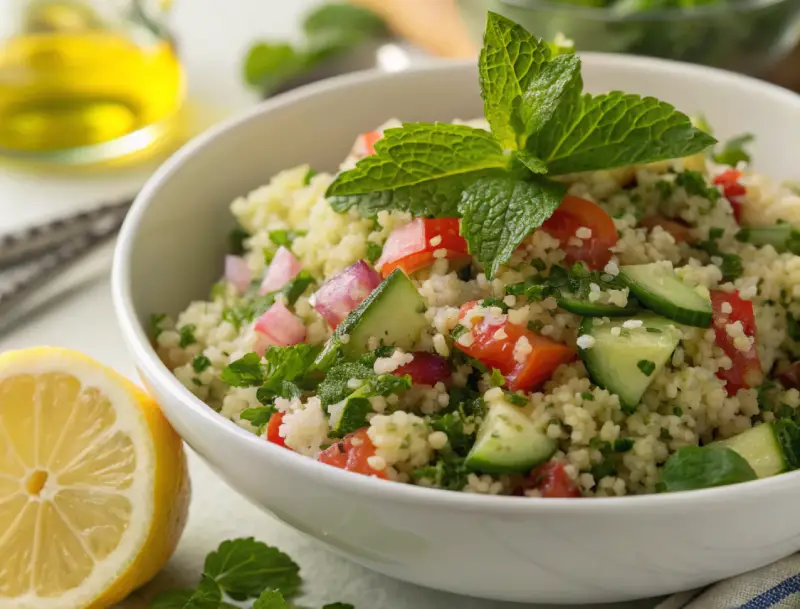Tabbouleh
Description:
Tabbouleh is a bright, refreshing, and nutritious Middle Eastern salad that has gained popularity worldwide for its vibrant flavors and healthy ingredients. Traditionally, it’s made with bulgur wheat, fresh vegetables, and herbs, making it a light yet flavorful dish that’s perfect for a side dish, appetizer, or light meal. It’s typically dressed in olive oil and lemon juice, bringing out the natural flavors of the ingredients.
Ingredients:
- 1/2 cup bulgur wheat (fine)
- 2 cups flat-leaf parsley, finely chopped
- 1/2 cup fresh mint leaves, finely chopped
- 1 cup tomatoes, finely diced
- 1/2 cucumber, finely diced (optional)
- 1/4 cup red onion, finely diced
- 2-3 tbsp olive oil
- 2-3 tbsp fresh lemon juice
- Salt and pepper, to taste
Calories:
- One serving of Tabbouleh (about 1/2 cup) contains approximately 120-150 calories.
- The calories can vary depending on the amount of olive oil and other ingredients used.
How to Cook:
- Prepare the bulgur wheat: In a large bowl, place the bulgur and pour over 1/2 cup of boiling water. Let it sit for 10-15 minutes until the bulgur softens. Fluff with a fork to separate the grains.
- Chop the vegetables and herbs: Finely chop the parsley, mint, tomatoes, cucumber, and red onion.
- Mix the salad: Add the chopped vegetables and herbs into the bowl with the bulgur. Stir everything together gently.
- Season: Drizzle the olive oil and fresh lemon juice over the salad. Season with salt and pepper to taste, and mix to combine.
- Chill and serve: Let the tabbouleh sit for about 30 minutes to allow the flavors to meld. It can be served chilled or at room temperature.
History:
Tabbouleh is a traditional Levantine dish originating from the mountainous regions of Lebanon, Syria, and Palestine. The name « tabbouleh » comes from the Arabic word « tabbula, » which means « seasoned. » Traditionally, it was made with more herbs than bulgur, reflecting the region’s abundance of fresh ingredients. Over time, it evolved with more modern variations, and it became a popular salad in Mediterranean cuisine worldwide. It is especially common at Middle Eastern feasts, gatherings, and during the hot summer months, as it’s a light, refreshing dish.
Tabbouleh has been enjoyed for centuries, but its exact origins are debated. Some suggest it was a dish of ancient civilizations, while others believe it gained prominence in the 19th century in Lebanon. Regardless of its exact origins, Tabbouleh remains a timeless favorite due to its simplicity, fresh ingredients, and health benefits.





